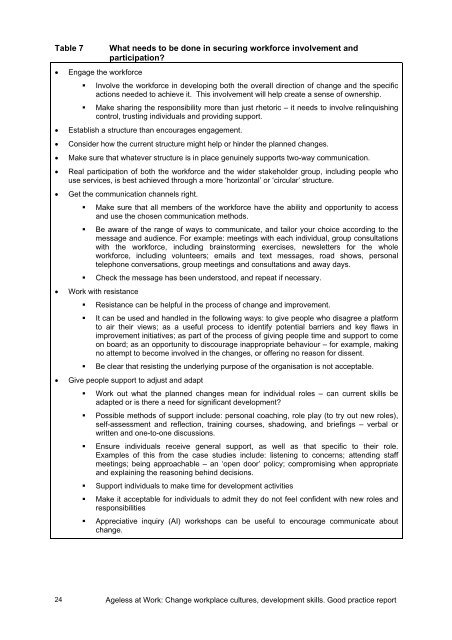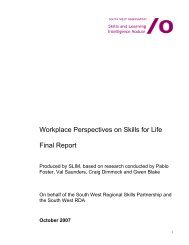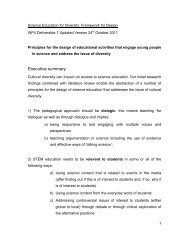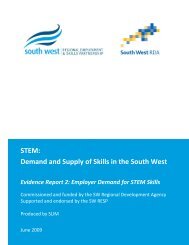Ageless at Work - Skills for Care
Ageless at Work - Skills for Care
Ageless at Work - Skills for Care
You also want an ePaper? Increase the reach of your titles
YUMPU automatically turns print PDFs into web optimized ePapers that Google loves.
Table 7<br />
<br />
<br />
<br />
<br />
<br />
<br />
<br />
<br />
Engage the work<strong>for</strong>ce<br />
Wh<strong>at</strong> needs to be done in securing work<strong>for</strong>ce involvement and<br />
particip<strong>at</strong>ion?<br />
• Involve the work<strong>for</strong>ce in developing both the overall direction of change and the specific<br />
actions needed to achieve it. This involvement will help cre<strong>at</strong>e a sense of ownership.<br />
• Make sharing the responsibility more than just rhetoric – it needs to involve relinquishing<br />
control, trusting individuals and providing support.<br />
Establish a structure than encourages engagement.<br />
Consider how the current structure might help or hinder the planned changes.<br />
Make sure th<strong>at</strong> wh<strong>at</strong>ever structure is in place genuinely supports two-way communic<strong>at</strong>ion.<br />
Real particip<strong>at</strong>ion of both the work<strong>for</strong>ce and the wider stakeholder group, including people who<br />
use services, is best achieved through a more ‘horizontal’ or ‘circular’ structure.<br />
Get the communic<strong>at</strong>ion channels right.<br />
• Make sure th<strong>at</strong> all members of the work<strong>for</strong>ce have the ability and opportunity to access<br />
and use the chosen communic<strong>at</strong>ion methods.<br />
• Be aware of the range of ways to communic<strong>at</strong>e, and tailor your choice according to the<br />
message and audience. For example: meetings with each individual, group consult<strong>at</strong>ions<br />
with the work<strong>for</strong>ce, including brainstorming exercises, newsletters <strong>for</strong> the whole<br />
work<strong>for</strong>ce, including volunteers; emails and text messages, road shows, personal<br />
telephone convers<strong>at</strong>ions, group meetings and consult<strong>at</strong>ions and away days.<br />
• Check the message has been understood, and repe<strong>at</strong> if necessary.<br />
<strong>Work</strong> with resistance<br />
• Resistance can be helpful in the process of change and improvement.<br />
• It can be used and handled in the following ways: to give people who disagree a pl<strong>at</strong><strong>for</strong>m<br />
to air their views; as a useful process to identify potential barriers and key flaws in<br />
improvement initi<strong>at</strong>ives; as part of the process of giving people time and support to come<br />
on board; as an opportunity to discourage inappropri<strong>at</strong>e behaviour – <strong>for</strong> example, making<br />
no <strong>at</strong>tempt to become involved in the changes, or offering no reason <strong>for</strong> dissent.<br />
• Be clear th<strong>at</strong> resisting the underlying purpose of the organis<strong>at</strong>ion is not acceptable.<br />
Give people support to adjust and adapt<br />
• <strong>Work</strong> out wh<strong>at</strong> the planned changes mean <strong>for</strong> individual roles – can current skills be<br />
adapted or is there a need <strong>for</strong> significant development?<br />
• Possible methods of support include: personal coaching, role play (to try out new roles),<br />
self-assessment and reflection, training courses, shadowing, and briefings – verbal or<br />
written and one-to-one discussions.<br />
• Ensure individuals receive general support, as well as th<strong>at</strong> specific to their role.<br />
Examples of this from the case studies include: listening to concerns; <strong>at</strong>tending staff<br />
meetings; being approachable – an ‘open door’ policy; compromising when appropri<strong>at</strong>e<br />
and explaining the reasoning behind decisions.<br />
• Support individuals to make time <strong>for</strong> development activities<br />
• Make it acceptable <strong>for</strong> individuals to admit they do not feel confident with new roles and<br />
responsibilities<br />
• Appreci<strong>at</strong>ive inquiry (AI) workshops can be useful to encourage communic<strong>at</strong>e about<br />
change.<br />
24<br />
<strong>Ageless</strong> <strong>at</strong> <strong>Work</strong>: Change workplace cultures, development skills. Good practice report








